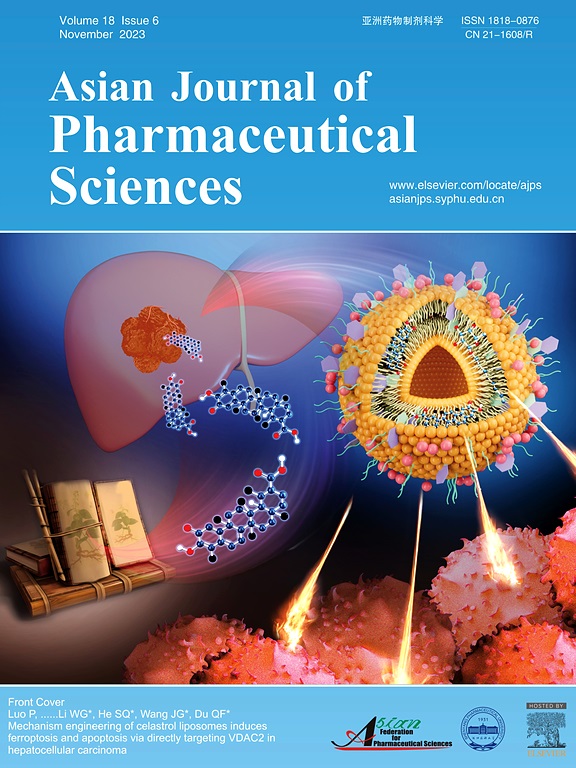Functionalized chitosan as nano-delivery platform for CRISPR-Cas9 in cancer treatment
IF 10.7
1区 医学
Q1 PHARMACOLOGY & PHARMACY
引用次数: 0
Abstract
CRISPR-Cas system permanently deletes any harmful gene-of-interest to combat cancer growth. Chitosan (CS) is a potential cancer therapeutic that mediates via PI3K/Akt/mTOR, MAPK and NF-kβ signaling pathway modulation. CS and its covalent derivatives have been designed as nanocarrier of CRISPR-Cas9 alone (plasmid or ribonucleoprotein) or in combination with chemical drug for cancer treatment. The nanocarrier was functionalized with polyethylene glycol (PEG), targeting ligand, cell penetrating ligand and its inherent positive zeta potential to mitigate premature clearance and particulate aggregation, and promote cancer cell/nucleus targeting and permeabilization to enable CRISPR-Cas9 acting on the host DNA. Different physicochemical attributes are required for the CS-based nanocarrier to survive from the administration site, through the systemic circulation-extracellular matrix-mucus-mucosa axis, to the nucleus target. CRISPR-Cas9 delivery is met with heterogeneous uptake by the cancer cells. Choice of excipients such as targeting ligand and PEG may be inappropriate due to lacking overexpressed cancer receptor or availability of excessive metabolizing enzyme and immunoglobulin that defies the survival and action of these excipients rendering nanocarrier fails to reach the target site. Cancer omics analysis should be implied to select excipients which meet the pathophysiological needs, and chitosan nanocarrier with a “transformative physicochemical behavior” is essential to succeed CRISPR-Cas9 delivery.

功能化壳聚糖作为CRISPR-Cas9在癌症治疗中的纳米递送平台
CRISPR-Cas系统永久删除任何有害基因,以对抗癌症的生长。壳聚糖(CS)通过介导PI3K/Akt/mTOR、MAPK和NF-kβ信号通路,是一种潜在的癌症治疗药物。CS及其共价衍生物已被设计为CRISPR-Cas9单独(质粒或核糖核蛋白)或与化学药物联合的纳米载体,用于癌症治疗。利用聚乙二醇(PEG)功能化纳米载体,靶向配体、细胞穿透配体及其固有的正zeta电位,减轻过早清除和颗粒聚集,促进癌细胞/细胞核的靶向和渗透,使CRISPR-Cas9能够作用于宿主DNA。基于cs的纳米载体需要不同的物理化学特性才能从给药部位存活下来,通过体循环-细胞外基质-粘液-粘膜轴,到达细胞核靶点。CRISPR-Cas9递送会被癌细胞异质摄取。由于缺乏过表达的癌症受体,或存在过多的代谢酶和免疫球蛋白,导致辅料如靶向配体和PEG的选择不合适,导致纳米载体无法到达靶部位。通过肿瘤组学分析,选择符合病理生理需要的赋形剂,而具有“转化物理化学行为”的壳聚糖纳米载体是CRISPR-Cas9成功递送的必要条件。
本文章由计算机程序翻译,如有差异,请以英文原文为准。
求助全文
约1分钟内获得全文
求助全文
来源期刊

Asian Journal of Pharmaceutical Sciences
Pharmacology, Toxicology and Pharmaceutics-Pharmaceutical Science
CiteScore
18.30
自引率
2.90%
发文量
11
审稿时长
14 days
期刊介绍:
The Asian Journal of Pharmaceutical Sciences (AJPS) serves as the official journal of the Asian Federation for Pharmaceutical Sciences (AFPS). Recognized by the Science Citation Index Expanded (SCIE), AJPS offers a platform for the reporting of advancements, production methodologies, technologies, initiatives, and the practical application of scientific knowledge in the field of pharmaceutics. The journal covers a wide range of topics including but not limited to controlled drug release systems, drug targeting, physical pharmacy, pharmacodynamics, pharmacokinetics, pharmacogenomics, biopharmaceutics, drug and prodrug design, pharmaceutical analysis, drug stability, quality control, pharmaceutical engineering, and material sciences.
 求助内容:
求助内容: 应助结果提醒方式:
应助结果提醒方式:


